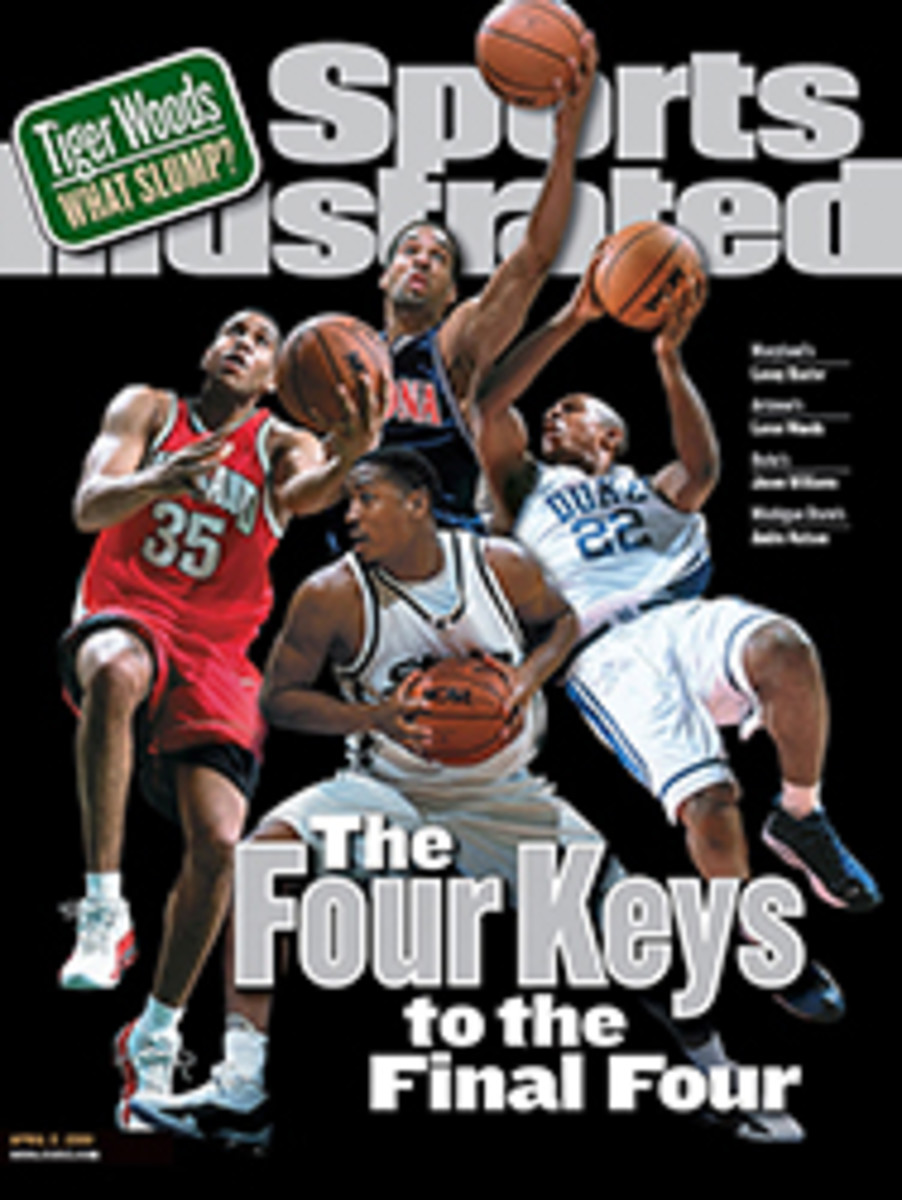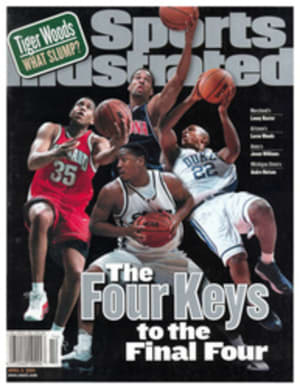
Notebook
Success, at Long Last
No Goetze, No Glory
Vicki Goetze-Ackerman muscled up on the 18th tee at Mission
Hills Country Club during last week's Nabisco Championship,
hitting her drive as far as she could. The ball took off high
with a draw and got a healthy bounce. After calculating that it
had traveled all of 242 yards, she smiled and said, "Very large
for me."
Goetze-Ackerman, 28, averages 222.8 yards a drive, which puts
her 173rd on the LPGA tour in distance. Though four yards longer
than last year, she's still 50 yards behind the tour leader,
Akiko Fukushima, and that difference underscores what had been
the rap against the two-time U.S. Women's Amateur champion:
Goetze-Ackerman was too light a hitter to keep up with the big
girls.
In 1999, her sixth season as a pro, the slight, 5'5"
Goetze-Ackerman finished with her highest-ever scoring average,
74.38. That's when she stopped worrying about length. Her game
improved almost immediately. Last year she had a career-low
stroke average (72.51), her best tour finish (a tie for second
place in the Corning Classic) and her highest ranking on the
money list (51st).
This season she has continued her resurgence. Goetze-Ackerman,
who had only eight top 10 finishes going into the year, already
has four in seven starts in 2001, the last one coming two weeks
ago when she closed with a career-low 65 at the Standard Register
Ping. She is tied for second on the tour in putting (27.86 a
round) and ranks 15th on the money list. "I had no idea this was
going to happen," says Goetze-Ackerman, who shot a two-over 74 to
finish 58th at the Nabisco, 19 strokes behind winner Annika
Sorenstam. "I'm still not where I want to be, but I'm very happy
with the progress."
She's not even close to reaching her former stature. As Vicki
Goetze, she was one of the great prodigies of women's golf. She
played her first tournament at age five, dominated the junior
ranks and won the 1989 Amateur when she was 16. As a freshman at
Georgia she won the NCAA individual title. When Goetze defeated
Sorenstam one up in the final of the '92 Amateur, it was Goetze,
not her opponent, who looked like a shoo-in for the Hall of Fame.
"I was mentally stronger at that time," Goetze-Ackerman says.
In retrospect Goetze-Ackerman probably wasn't ready for life on
the LPGA tour--and the resentment that ballyhooed amateurs
encounter from veterans--when she turned pro at 20. "I had never
encountered confrontation, and the tour can be a tough place,"
she says. "I had never been alone. I was lonely and unhappy and
frustrated. I went a whole year without playing a practice round
with someone else, without having dinner with someone."
Marrying former club pro Jim Ackerman in 1997 increased her
happiness. However, when her performance continued to fall short
of expectations, Goetze-Ackerman began to listen to critics who
insisted that she needed more distance. Soon her vaunted short
game began to collapse under the strain of constantly trying to
save par. Her confidence shot, she missed the cut in 27 of 39
starts in '98 and '99. "I lost track of the kind of golfer I am,"
she says.
Instead of quitting, she took action. Before the 2000 season she
began working with the New York Yankees' sports psychologist,
Fran Pirozzolo. "Fran got me away from measuring my worth as a
person by how I played," Goetze-Ackerman says. Her swing coach,
Paul Marchand, who also tutors Fred Couples and Colin
Montgomerie, wants Goetze-Ackerman to stop thinking about
distance. "Vicki's game is accuracy and consistency," he says.
"She doesn't need to be long if everything else is working right."
Goetze-Ackerman carries six woods, all the way up to an
eleven-wood, which she hits 150 yards. Her lowest iron is a six,
which she hits 138 yards. That makes for a funny contrast when
she plays with her best friend on tour, Caroline Blaylock, who
last year led the LPGA in driving. "We're known as the Long and
the Short of It," says Blaylock. "I remember Vicki as an
absolute phenom, and it's so great to see her playing her game
again."
Course Construction
Building Boom Produces a Glut
Since the mid-'90s, the U.S. has experienced an unprecedented
boom in golf-course construction. Last year a record 524 courses
opened, and that was only the crest of a wave that has seen more
than 2,800 facilities--87% of them public--come on line in the
last six years. Now, though, the people who build courses for a
living are concerned that the boom is about to go bust.
Three factors portend the slowdown: a worsening general economy,
too many courses and exorbitant greens fees. National Golf
Foundation studies show that the number of rounds played in the
U.S. has remained about the same throughout the building boom.
With more than 17,000 courses available, supply has surpassed
demand in many parts of the country. As a result, lenders are
less likely to finance new projects. "I don't know whether
there's a glut yet," says course designer Robin Nelson, "but
there are so many courses that I think people are seeing a
shakeout, and that means a slowdown."
It costs about $3 million to build a public course in most
places. However, in densely populated locales, where land is
expensive, or in environmentally sensitive areas, where special
construction methods must be applied, the cost can soar five
times as high or more. Something as innocuous as the web of cart
paths required at resort courses can cost more than $1 million.
Which brings us to the seemingly outrageous greens fees charged
at some courses. Generally, course operators make a profit by
charging about $10 for every $1 million they spend constructing a
course, so if the facility costs, say, $10 million, the greens
fee will be $100. That's too rich for many golfers. "I'm most
concerned about the price of golf," Nelson says. "I wonder if the
guys building these high-end courses would pay $200 to play them.
I think some people will have to lower their prices and take a
hit to stay in business."
During the boom, course designers frequently added expensive eye
candy--artificial waterfalls, elaborate mounding, excessive
plantings--to their projects. In the future the emphasis will be
put on such virtues as thrifty minimalist design and working
within a strict budget. Says architect James Engh, "We have to
build smart courses that people can afford to play. The days of
excess are over."
COLOR PHOTO: ROBERT BECK By focusing on her strength, not her weakness, Goetze-Ackerman has turned around her career.
COLOR PHOTO: JOHN AND JEANNINE HENEBRY Expensive artificial flourishes like those found at Las Vegas's Shadow Creek are out of vogue.
JAIME'S TOP 10
Increasingly, daily-fee operations popping up across the U.S. are
aimed at the guy with the fat wallet, while the avid golfer
looking for quality at a reasonable price is beginning to wonder
if he can still afford the game. Not all is lost, however. Here's
my list of the best new public courses that are great buys.
1. PINON HILLS GOLF Course Farmington, N.Mex. Considered by many
the best bargain in the U.S., the course blends naturally into
the rugged, high-desert terrain. Greens fee: $20 to $25.
2. KOKOPELLI GOLF CLUB Marion, Ill. Designed by Steve Smyers,
Kokopelli is a solid test for beginners and good players. Greens
fee: $26 to $30.
3. WILD HORSE GOLF CLUB Gothenburg, Neb. Dan Proctor and Dave
Axland have built something very much like nearby Sand Hills on
striking sand-based bluffs. Greens fee: $30 to $33.
4. PGA OF SOUTHERN CALIFORNIA GOLF CLUB AT OAK VALLEY Calimesa,
Calif. This Lee Schmidt and Brian Curley creation has 36 holes
and a state-of-the-art range. Greens fee: $50 to $75.
5. EL DIABLO GOLF AND COUNTRY CLUB Citrus Springs, Fla. This Jim
Fazio-designed course takes advantage of the rolling land and
abundant pines. Greens fees: $54 to $59.
6. THE CAPTAINS GOLF COURSE Brewster, Mass. Carved through
graceful pines on Cape Cod, the Captains is 36 holes of
uncomplicated golf. Greens fee: $45 to $55.
7. HAWKTREE GOLF CLUB Bismarck, N.Dak. Hawktree is a large,
muscular design by James Engh on rolling, windswept terrain in
the Badlands. Greens fee: $42.
8. BLACK HORSE GOLF CLUB Cypress, Texas. This 36-hole complex by
Peter Jacobsen and Jim Hardy near Houston is a pleasing blend of
wetlands, forests and lakes. Greens fee: $55 to $65.
9. RED HAWK RIDGE GOLF COURSE Castle Rock, Colo. This city-owned
James Engh design is a textbook example of low-cost quality.
Greens fee: $33 to $36.
10. EAGLE POINT GOLF COURSE Medford, Ore. Robert Trent Jones Jr.
provided a distinctive alternative with this tranquil Pacific
Northwest setting. Greens fee: $50 to $58.
Trust Me
Annika Sorenstam and Karrie Webb will be sharing a seesaw for
years. Webb is physically superior, but Sorenstam has the steely
determination to challenge Webb's natural talent. Annika and
Karrie are much like Chris Evert and Martina Navratilova were in
tennis, and as long as they remain motivated, the battle between
these two Hall of Famers will be the best rivalry in golf.
Foursomes
What do these players have in common?
--Raymond Floyd
--Jack Nicklaus
--Arnold Palmer
--Craig Wood
They're the only golfers to lead the Masters wire to wire. Wood
did it in 1941, Palmer in '60, Nicklaus in '72 and Floyd in '76.
Feedback
What's most responsible for the record-breaking scores this year?
Better conditions 10%
Better players 38%
Better equipment 52%
--Based on 3,143 responses to our informal survey
Next question: Do you think Augusta National should lift its ban
on CBS's Gary McCord? Vote at golfplus.cnnsi.com.
Thesaurus
Synonyms for: High scores
Bo Derek (10), frog eyes (88), Gretzky (99), Maxwell Smart (86),
Mean Joe Greene (75), piano keys (88), quad city, radio station
(100s), Red Grange (77), snowman with a crutch (81), Sunset Strip
(77), trombones (76), the trillions.
Numbers
Instead of asking, Who's the best player who hasn't won a major?
we posed the question, Which players in the Masters field have
made the most starts in the Grand Slam events without winning
one? Here are the top five.
TOUR TOTAL
WINS WINS MAJORS
Scott Hoch 8 14 56
C. Montgomerie 0 26 38
Phil Mickelson 18 19 34
David Duval 12 12 24
Jesper Parnevik 5 14 23

